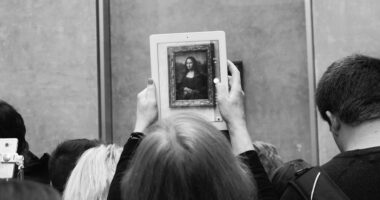Non-Fungible Token Art, or NFT Art, has been a huge hit in the art scene lately. It has completely changed how we view and value digital art and given creators new platforms for exhibiting and commercializing their creations. This essay will examine the NFT Art world, its increasing popularity, the leading artists in the field, their creative process, the impact NFT Art will have on digital art in the future, job opportunities in the NFT Art sector, the role of blockchain technology, the characteristics of NFT Art collectors, the value of keeping up with NFT Art trends via newsletters, and the wider societal implications of NFT Art.
Key Takeaways
- NFT art is a new form of digital art that is gaining popularity in the art world.
- The rise of NFT artists has created new opportunities for creatives to monetize their work.
- Top NFT artists in the industry include Beeple, Pak, Trevor Jones, Mad Dog Jones, and Krista Kim.
- The creative process behind NFT art involves using digital tools to create unique and one-of-a-kind pieces.
- NFT art has the potential to revolutionize the art world and society as a whole, with blockchain technology playing a key role in its development.
In recent years, NFT Art has become incredibly popular due to the growing acceptance of digital art and the growing interest in blockchain technology. Artists can produce one-of-a-kind digital goods with NFTs, which can be exchanged, purchased, & sold on a number of online marketplaces. Artists can now monetize their digital works in ways that were previously unthinkable, opening up a whole new world of possibilities for them.
The ability to use blockchain technology to verify authenticity and ownership is one of the main reasons behind the rise of NFT Art. A blockchain, which functions as a decentralized ledger to confirm the provenance and ownership of the artwork, records each NFT. A significant obstacle that digital artists confront has been resolved: the ease with which their work can be replicated and copied without permission. Some of today’s most prominent and prosperous artists come from the NFT Art scene. Through the selling of their NFTs, these artists have not only established themselves as prominent figures in the world of digital art but have also seen considerable financial success.
One such artist is Beeple, whose digital piece “Everydays: The First 5000 Days” fetched an incredible $69 million at a Christie’s auction in 2021. The bold & provocative style of Beeple’s work is well known, and it frequently explores themes of popular culture, politics, & technology. Pak is another well-known NFT artist.
| Artist Name | Number of NFTs Sold | Average Sale Price | Total Sales Volume |
|---|---|---|---|
| Pak | 1,000 | 10 ETH | 10,000 ETH |
| Trevor Jones | 500 | 5 ETH | 2,500 ETH |
| Mad Dog Jones | 300 | 3 ETH | 900 ETH |
| FEWOCiOUS | 200 | 2 ETH | 400 ETH |
| Grimes | 100 | 1 ETH | 100 ETH |
An anonymous creator of abstract and provocative digital art, Pak has developed a cult following. Millions of dollars have been paid for Pak’s NFTs, and their work never fails to enthrall viewers everywhere. To create their digital artwork, NFT artists use a range of tools & techniques. While some artists work with 3D modeling software to create complex & immersive virtual worlds, many artists start their designs with digital software like Adobe Photoshop or Illustrator.
There is no way to overestimate the importance of technology in the creative process. Innovative technologies like virtual reality (VR) and augmented reality (AR) are frequently used by NFT artists to improve their works of art and give their audience engaging experiences. By pushing the limits of conventional art forms, these technologies enable artists to produce genuinely one-of-a-kind, interactive works.
The field of digital art could undergo a total transformation thanks to NFT Art. It gives artists an innovative means of making money off of their creations & connecting with a worldwide market. With the emergence of NFT Art, the art world is becoming more democratic as artists are no longer dependent on established gatekeepers like galleries and auction houses to present and market their work. In the digital age, NFT Art also has the power to completely reinterpret what ownership means. Artists can make a new standard for the art market by employing blockchain technology to verify the legitimacy and ownership of their digital works.
Intellectual property rights and copyright in the digital sphere will be significantly impacted by this in the future. Creatives now have a plethora of job options thanks to the growth of NFT Art. There are many different jobs available in the NFT Art sector, ranging from blockchain developers & art curators to digital artists and designers. The art that is offered for sale as NFTs is largely the product of digital designers and artists. They are in great demand in this field for their digital art, graphic design, and animation skills.
On the other hand, the platforms and infrastructure needed to facilitate the creation and trading of NFTs are built by blockchain developers. They work on the security and scalability of the underlying technology that drives NFT Art. An essential part of the NFT Art industry is played by art collectors and curators. They curate collections, assist in identifying and showcasing gifted artists, and offer advice and knowledge to buyers of NFT Art.
In the realm of NFT Art, blockchain technology is essential. It functions as the foundational technology that makes it possible to create, exchange, and authenticate the ownership of NFTs. As a decentralized ledger that confirms the legitimacy & ownership of the artwork, each NFT is registered on a blockchain.
There are many advantages to using blockchain technology in NFT Art. First of all, it resolves a significant issue that digital artists confront: it guarantees the provenance & authenticity of the artwork. Second, because every transaction is recorded on the blockchain and easily verifiable, it allows artists to make money off of their creations through the sale of NFTs. Last but not least, blockchain technology offers a decentralized & transparent platform for communication between collectors and artists, doing away with the need for middlemen and lowering transaction fees.
The use of blockchain in NFT Art is not without its limitations, though. There have been questions about the environmental impact of blockchain technology due to its energy consumption, especially when it comes to cryptocurrencies like Ethereum. Also, collectors and artists may encounter difficulties due to the high transaction fees and scalability problems associated with blockchain networks.
The demographics and backgrounds of NFT Art collectors are varied. A few of the things that draw them to NFT Art are the chance to support their favorite artists, acquire rare and distinctive digital assets, and possibly even turn a profit from the artwork’s appreciation. A subset of collectors are traditional art enthusiasts who view NFT Art as an intriguing new medium to work with. Some are tech-savvy people who are drawn to NFTs because they are novel & state-of-the-art. Also, some collectors view NFT Art as a chance to make investments in an effort to profit from the rising demand for digital art.
For artists as well as collectors and enthusiasts, it is imperative to stay current with NFT Art trends. A great way to keep up to date on new artists, upcoming auctions, & industry trends is to subscribe to the NFT Art newsletters. The NFT Art newsletters frequently include market trends analysis, artist interviews, and reviews of recent NFT releases. They help readers learn about new artists & broaden their understanding of the NFT Art scene by offering a carefully chosen collection of NFT Art that is intriguing.
A fantastic method to stay involved in the community, get advice from professionals in the field, and make well-informed decisions when purchasing or disposing of NFT Art is to sign up for NFT Art newsletters. Beyond the realm of art, NFT Art has a profound effect. By upending established ideas of authenticity and ownership, it has the power to fundamentally alter how we view and appreciate digital art. The environmental effects of blockchain technology and the future of copyright in the digital era have also been discussed in relation to NFT Art. Also, NFT Art has given artists new chances by giving them a platform to exhibit and sell their work to a worldwide audience.
Due to its ability to get past conventional gatekeepers and build their own reputation and fan base, it has democratized the art world. In summary, NFT Art is a major force in the art world that is transforming the ways in which we produce, acquire, and market digital art. In addition to questioning conventional ideas of ownership and authenticity, it has given artists new avenues for self-expression and financial gain. It will be interesting to observe how the NFT Art industry affects digital art and society at large as it develops further.
Looking to explore the world of top NFT artists? Check out this fascinating article on NFT-Jobs.com that delves into the rise of NFTs and highlights some of the most influential artists in the space. From renowned creators like Beeple and Pak to emerging talents making waves in the digital art scene, this article provides valuable insights into the NFT art market. Discover how these artists are revolutionizing the art world and shaping the future of digital ownership. Don’t miss out on this captivating read! Click here to dive into the world of top NFT artists.
FAQs
What are NFTs?
NFTs, or non-fungible tokens, are unique digital assets that are stored on a blockchain. They are used to represent ownership of digital art, music, videos, and other types of creative content.
Who are the top NFT artists?
The top NFT artists are subjective and can vary depending on the platform and community. However, some of the most well-known NFT artists include Beeple, Trevor Jones, Pak, Mad Dog Jones, and Krista Kim.
What makes an NFT valuable?
The value of an NFT is determined by various factors, including the artist’s reputation, the rarity of the artwork, the demand from collectors, and the uniqueness of the token. Additionally, the history and provenance of the artwork can also impact its value.
How do I buy NFTs?
To buy NFTs, you need to have a cryptocurrency wallet and access to an NFT marketplace. Some popular NFT marketplaces include OpenSea, Nifty Gateway, and SuperRare. You can purchase NFTs using cryptocurrency such as Ethereum or Bitcoin.
What are the benefits of owning NFTs?
Owning NFTs allows you to own a unique piece of digital art or content that is verified on the blockchain. It also provides a way for artists to monetize their work and for collectors to invest in rare and valuable pieces. Additionally, owning NFTs can provide a sense of exclusivity and ownership in the digital world.





